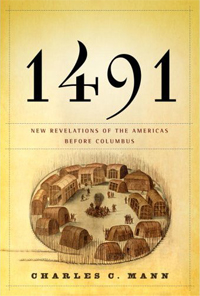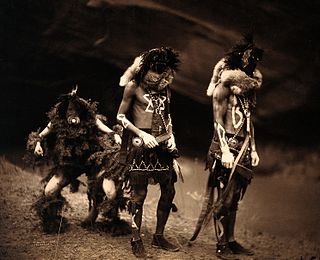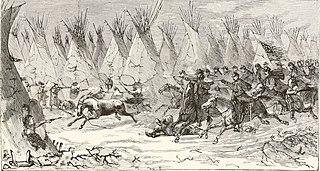Related Research Articles

Native Americans, sometimes called American Indians, First Americans, or Indigenous Americans, are the Indigenous peoples of the United States or portions thereof, such as American Indians from the contiguous United States and Alaska Natives. The United States Census Bureau defines Native American as "all people indigenous to the United States and its territories, including Native Hawaiian and Other Pacific Islanders, whose data are published separately from American Indians and Alaska Natives". The U.S. census tracks data from American Indians and Alaska Native separately from Native Hawaiian and other Pacific Islanders, who include Samoan Americans and Chamorros.

During the Age of Discovery, a large scale colonization of the Americas, involving a number of European countries, took place primarily between the late 15th century and the early 19th century. The Norse had explored and colonized areas of Europe and the North Atlantic, colonizing Greenland and creating a short term settlement near the northern tip of Newfoundland circa 1000 AD. However, due to its long duration and importance, the later colonization by the European powers involving the continents of North America and South America is more well-known.

The American Indian Wars, also known as the American Frontier Wars, and the Indian Wars, were initially fought by European nations and their colonists in North America, and later on by the United States government and American settlers, against various American Indian tribes. These conflicts occurred in the United States from the time of the earliest colonial settlements in the 17th century until the end of the 19th century. The various wars resulted from a wide variety of factors, the most common being the desire of settlers and governments for Indian tribes' lands. The European powers and their colonies also enlisted allied Indian tribes to help them conduct warfare against each other's colonial settlements. After the American Revolution, many conflicts were local to specific states or regions and frequently involved disputes over land use; some entailed cycles of violent reprisal.

The Nez Perce War was an armed conflict in 1877 in the Western United States that pitted several bands of the Nez Perce tribe of Native Americans and their allies, a small band of the Palouse tribe led by Red Echo (Hahtalekin) and Bald Head, against the United States Army. Fought between June and October, the conflict stemmed from the refusal of several bands of the Nez Perce, dubbed "non-treaty Indians," to give up their ancestral lands in the Pacific Northwest and move to an Indian reservation in Idaho Territory. This forced removal was in violation of the 1855 Treaty of Walla Walla, which granted the tribe 7.5 million acres of their ancestral lands and the right to hunt and fish on lands ceded to the U.S. government.

Population figures for the Indigenous peoples of the Americas prior to European colonization have been difficult to establish. By the end of the 20th century, most scholars gravitated toward an estimate of around 50 million, with some historians arguing for an estimate of 100 million or more.
Native Americans or Native American usually refers to Native Americans in the United States.

1491: New Revelations of the Americas Before Columbus is a 2005 non-fiction book by American author and science writer Charles C. Mann about the pre-Columbian Americas. It was the 2006 winner of the National Academies Communication Award for best creative work that helps the public's understanding of topics in science, engineering or medicine.
Plastic shamans, or plastic medicine people, is a pejorative colloquialism applied to individuals who are attempting to pass themselves off as shamans, holy people, or other traditional spiritual leaders, but who have no genuine connection to the traditions or cultures they claim to represent. In some cases, the "plastic shaman" may have some genuine cultural connection, but is seen to be exploiting that knowledge for ego, power, or money.

Indian Givers: How the Indians of the Americas Transformed the World is a 1988 non-fiction book by American author Jack Weatherford. The book explains the many ways in which the various peoples native to North and South America contributed to the modern world's culture, manufacturing, medicine, markets, and other aspects of modern life.

Native American religions are the spiritual practices of the Native Americans in the United States. Ceremonial ways can vary widely and are based on the differing histories and beliefs of individual nations, tribes and bands. Early European explorers describe individual Native American tribes and even small bands as each having their own religious practices. Theology may be monotheistic, polytheistic, henotheistic, animistic, shamanistic, pantheistic or any combination thereof, among others. Traditional beliefs are usually passed down in the forms of oral histories, stories, allegories, and principles.
The red road is a modern English-language concept of the right path of life, as inspired by some of the beliefs found in a variety of Native American spiritual teachings. The term is used primarily in the Pan-Indian and New Age communities, and rarely among traditional Indigenous people, who have terms in their own languages for their spiritual ways. Native Americans' spiritual teachings are diverse. With over 500 federally-recognized tribes in just the US, while some regional practices and beliefs might be similar, the cultures are highly individualized. Individual ceremonies and particular beliefs tend to be unique to the people of these diverse bands, tribes and nations.

Two-spirit is a contemporary pan-Indian umbrella term used by some Indigenous North Americans to describe Native people who fulfill a traditional third-gender social role in their communities.
Pan-Indianism is a philosophical and political approach promoting unity, and to some extent cultural homogenization, among different Indigenous groups in the Americas regardless of tribal distinctions and cultural differences.
The following is an alphabetical list of topics related to Indigenous peoples in Canada, comprising the First Nations, Inuit and Métis peoples.

This is a chronological list of significant or pivotal moments in the development of Native American art or the visual arts of the Indigenous peoples of the Americas. Earlier dates, especially before the 18th century, are mostly approximate.
Debra Cecille Magpie Earling is a Native American novelist, and short story writer. She is a member of the Bitterroot Salish (tribe). She is the author of Perma Red and The Lost Journals of Sacajewea, which was on display at the Missoula Museum of Art in late 2011. Her work has also appeared in Ploughshares, the Northeast Indian Quarterly, and many anthologies.
Alvin M. Josephy Jr. was an American historian who specialized in Native American issues. New York Times reviewer Herbert Mitgang called him in 1982 the "leading non-Indian writer about Native Americans".

The history of Native Americans in the United States began before the founding of the country, tens of thousands of years ago with the settlement of the Americas by the Paleo-Indians. Anthropologists and archeologists have identified and studied a wide variety of cultures that existed during this era. Their subsequent contact with Europeans had a profound impact on their history afterwards.

The Great Sioux Nation: Sitting in Judgment on America is a book edited by Roxanne Dunbar-Ortiz, "An Oral History of the Sioux Nation and Its Struggle for Sovereignty", that documents the 1974 "Lincoln Treaty Hearing". Testimony produced during that hearing has been cited by the International Indian Treaty Council in advocating for Indigenous sovereignty and treaty rights, efforts which eventually saw the 2007 Declaration on the Rights of Indigenous Peoples.

The destruction of Native American peoples, cultures, and languages has been characterized as genocide. The question of whether this event constitutes genocide is debated amongst scholars. Debates are ongoing over whether the entire process, or specific periods and local occurrences, meet the legal definition of genocide. Raphael Lemkin, who coined the term "genocide", considered the displacement of Native Americans by European settlers as a historical example of genocide. However, others, like historian Gary Anderson, contend that genocide does not accurately characterize any aspect of American history, suggesting instead that ethnic cleansing is a more appropriate term.
References
- ↑ Josephy, Alvin M. Jr. (1994). 500 Nations an Illustrated History of North American Indians . New York, New York: Alfred A, Knopf. p. Title. ISBN 0-679-42930-1.
- 1 2 3 4 5 6 7 8 Leustig, Jack (2006). "The Documentary Episodes". The 500 NATIONS Encore Venture. Tig Productions Inc. and Katahdin Productions, LLC. Archived from the original on 2008-05-03. Retrieved 2010-03-09.
- ↑ Makris, Steve (February 15, 1996). "A macro-look at native history". Newspapers.com. Edmonton Journal. p. 54. Retrieved 2024-03-29.